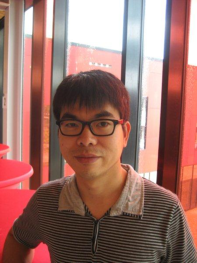Dynamical wetting transitions: liquid film deposition and air entrainment
Promotion date: 30. August 2012
Promotor: Prof. dr. Detlef Lohse
Assistant promotor: Dr. Jacco H. Snoeijer
| The entrainment of air by advancing contact lines was studied both theoretically and experimentally, by plunging a solid plate into a reservoir of viscous silicone oil of various viscosities. Above an entrainment velocity, we observed the formation of an air film, which is unstable and subsequently decays into bubbles. During the breakup of the air film, we observed the oil reestablished the contact with the solid and formed the so-called "rewetting bridges". The "bridges" spread out similar to the dewetting holes but the roles of air and liquid are exchanged. The spreading speed of the "rewetting" bridges are orders of magnitude larger than the dewetting speed. Strikingly, we found both experimentally and theoretically that the entrainment velocity depends significantly on the viscosity of the air. This implies the flow inside the air film plays a crucial role. |
Was your research application oriented?
My research was part of a project initiated by the ASML company. To improve the resolution of immersion lithography, a portion of water is injected between the lens and the substrate and maintained there in order to increase the optical resolutions. The problem is that, when the substrate is moving too fast, droplets are emitted at the receding part of the water. Similarly, at much higher speed, air bubbles are observed in the advancing part.
These dynamic processes are not yet fully understood. I focused on these phenomena and related them to various physical parameters. Though the questions are originated from practical conditions, for me the research was of a fundamental nature.
Experiments were performed in Paris at the ESPCI-institute, the École supérieure de physique et de chimie industrielles. Here in Twente we did the modelling work. My co-promotor dr. Jacco Snoeijer has long-term working relationships with prof. dr. Bruno Andreotti of ESPCI.
Did surprising results come out there during your project?
Because the air viscosity is so small compared to liquid viscosity, we expected the air is not to play a significant role in the phenomena. The experiments however showed that it does. This critical speed was found to depend on the air viscosity unexpectedly strong. We were able to predict these phenomena qualitatively in the end.
Results were published in Physical Review Letters. I also gave a talk on this problem at the Division of Fluid Dynamics (DFD) conferences of the American Physical Society, as I did at the Dutch FOM-meetings as well.
Being part of a big ASML-project we had meetings with other PhD’s involved every half year.
How did you develop personally as a researcher and scientist in these four years?
I learned to analyze a complex problem much better, and I understand the steps one has to undertake to solve them. Also I learned that discussing your field of research with fellow-scientists is an important characteristic of scientific progress.
What are your future plans?
At the moment I am looking for a post-doc position, preferably in Europe or in the United States. I love performing academic research, feeling free to analyze the problems nature sets upon you.
In the longer run I would like to return back to my home country China, hopefully being able to lead my own academic research group.

